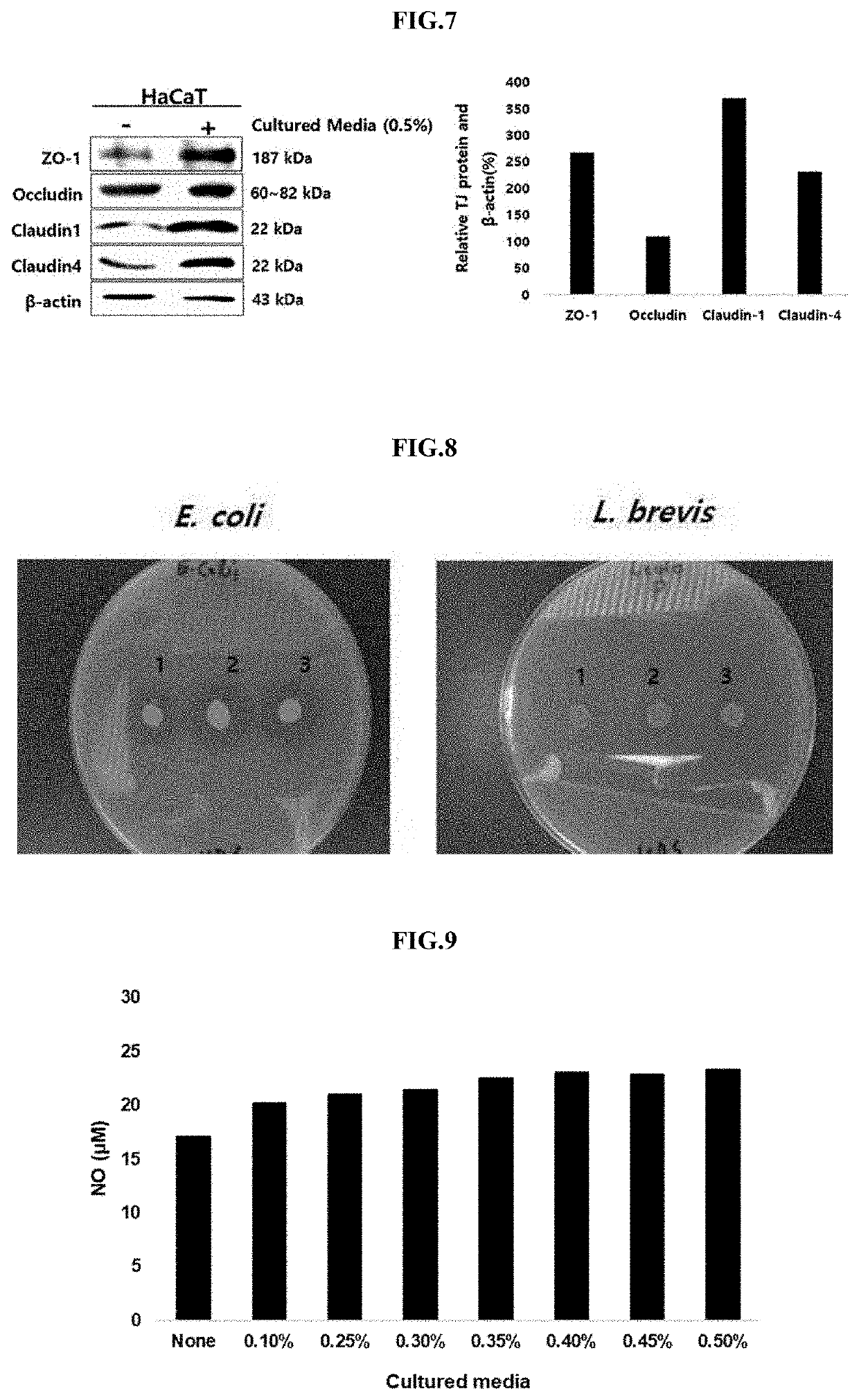Novel pediococcus pentosaceus ab 160011 strain and composition containing same
a technology of lactic acid bacteria and composition, which is applied in the field of new lactic acid bacteria strain and composition, can solve the problems of paracellular leakage (leaky gut), adverse immune response leading to harmful autoimmune diseases and food allergies, and damage to the function of tight junction in allergy, so as to improve the expression of proteins, improve the effect of skin moisturization, and improve the effect of acid resistance and bile resistan
- Summary
- Abstract
- Description
- Claims
- Application Information
AI Technical Summary
Benefits of technology
Problems solved by technology
Method used
Image
Examples
example
Example 1: Culture of Pathogens
[0044]In order to select lactic acid bacteria inhibiting the growth of pathogenic bacteria, the following bacteria were obtained from KCCM and cultured in the solid media presented in Table 3 below. Bacteria: Staphylococcus aureus (KCCM11335), Escherichia coli (KCCM11234), Bacillus cereus (KCCM40935), Staphylococcus epidermidis (KCCM40416), Pseudomonas (KCCM11321), Propionibacterium aeruginosa (KCCM41747), Salmonella enterica subsp. enterica (KCCM11806), Listeria monocytogenes (KCCM40307). Fungi (including fungi): Cryptococcus neoformans (KCCM50785), Candida albicans (KCCM11282), Aspergillus fumigatus (ATCC Mya-4609), Aspergillus niger (KCCM60332), Fusarium oxysporum (KCCM44187), Penicillium chrysogenum (KCCM60353) and Malassezia furfur (KCCM12679). Next, each colony of the pathogen was inoculated into a nutrient broth medium and incubated for 24 hours at an appropriate temperature (37° C. for E coli, Staphylococcus aureus and Bacillus; 30° C. for Cryp...
example 2
of Antimicrobial and Antifungal Activities
[0045]For the isolated strains, their antimicrobial and antifungal activities were detected. First, each isolated strain stored at −80° C. was inoculated onto MRS solid medium and incubated at 37□ for 24 hours, and then the respective colonies were taken and suspended in 500 μl of
[0046]PBS to prepare a sample solution for subsequent antibacterial and antifungal activity experiments. Next, media for antimicrobial and antifungal activity tests of the isolation strains were prepared. To this end, the bacteria and fungi cultured and stored in Example 1 were inoculated into a nutrient media suitable for each growth and incubated for 24 hours. Next, the soft agar medium containing MRS (1%, w / w) was sterilized at 121□ for 15 minutes, cooled to 55□, and each culture medium including bacteria or fungi obtained above was inoculated with 1% (v / v) on the said MRS medium. The soft agar MRS medium inoculated with the bacteria or fungi was then poured into...
example 3
stance and Bile Resistance of the Lactic Acid Bacteria of the Present Invention
[0047]The isolated lactic acid bacteria strains were cultured in Lactobacilli MRS broth for more than 16 hours and then the 100 μl of the bacterial culture was inoculated into 100 μl of MRS broth with different pH conditions (pH7.0, pH2.5) in a 96 well plate, followed by incubation at 37□ for 24 hours. The survival rate of the lactic acid bacteria was measured by comparing the absorbances of the pH7.0 culture medium and the pH2.5 culture medium at 620 nm using Microplate reader. The cell viability for the acid resistance test was measured in the following manner.
Viability (%)=OD24 h, pH 2.5 / OD24 h, pH 7.0×100
[0048]To confirm bile resistance, the isolated lactic acid bacteria strain was cultured in Lactobacilli MRS broth for more than 16 hours and then 100 μl of the bacterial culture was inoculated into 100 μl of MRS broth with two conditions (MRS broth, MRS broth+0.3% oxgall) in a 96 well plate, followed ...
PUM
| Property | Measurement | Unit |
|---|---|---|
| temperature | aaaaa | aaaaa |
| temperature | aaaaa | aaaaa |
| v/v | aaaaa | aaaaa |
Abstract
Description
Claims
Application Information
 Login to View More
Login to View More - R&D
- Intellectual Property
- Life Sciences
- Materials
- Tech Scout
- Unparalleled Data Quality
- Higher Quality Content
- 60% Fewer Hallucinations
Browse by: Latest US Patents, China's latest patents, Technical Efficacy Thesaurus, Application Domain, Technology Topic, Popular Technical Reports.
© 2025 PatSnap. All rights reserved.Legal|Privacy policy|Modern Slavery Act Transparency Statement|Sitemap|About US| Contact US: help@patsnap.com



